| |
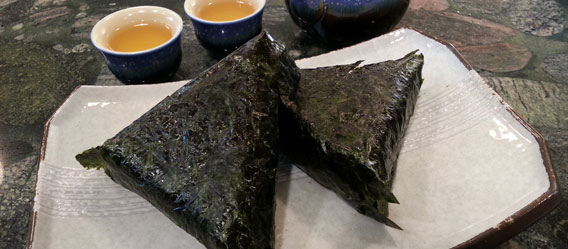
What is commonly found in Japanese convenience stores, an easy food item to pick up on the go, is made up of plain rice, wrapped in seaweed, and can be found in the shape of a triangle? What is tasty, healthy, and easy to make? If you are thinking onigiri, you are right!
What is an Onigiri?
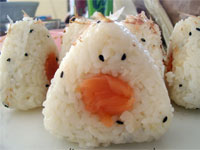 Onigiri is the name given to Japanese rice balls. Not to be confused with sushi, onigiri is a popular convenient food item in Japan. The name onigiri is made from two words “o” which means “to hold”, “grip” or “handle” and Nigiri which means “sushi made from rice”. Sometimes also known as omusubi, onigiri—Japanese rice ball is a popular food item in Japan. Onigiri is the name given to Japanese rice balls. Not to be confused with sushi, onigiri is a popular convenient food item in Japan. The name onigiri is made from two words “o” which means “to hold”, “grip” or “handle” and Nigiri which means “sushi made from rice”. Sometimes also known as omusubi, onigiri—Japanese rice ball is a popular food item in Japan.
Traditionally onigiri feature preserved ume, a form of green plum, wrapped in regular white rice. Other traditional onigiri filling include salted salmon, dried bonito flakes, kombu—edible kelp, and salted Pollock roe. Onigiri by definition uses regular white rice. A key difference between onigiri and sushi is the rice used. Sushi typically uses seasoned rice that has been treated with vinegar, mirin and sugar, onigiri, on the other hand uses regular white rice.
Seaweed or no Seaweed?
Onigiri can come in various shapes and sizes and are often wrapped with nori—roasted seaweed, but this is not always the case. Onigiri can come without seaweed wrapping, and can also feature creative and unique wrapping. Sometimes onigiri can be coated with seaweed flakes, sesame and Japanese seasoning, alternatives also include tobiko—roes, or soy paper. Even spam musubi, a Hawaii creation, is a form of onigiri.
Shapes and Sizes
Onigiri can come in several different shapes and all sizes. Home made onigiri can come in even greater variations. Onigiris have been made creatively to resemble pandas, bears, bunnies, and adorable rice balls with expressions.
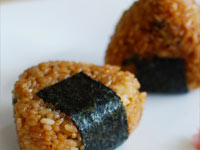 Typically, however, onigiri are generally the size of a palm or smaller. Commercial onigiri found in convenience or specialty stores in Japan are commonly in the shape of triangle, pillar, round, square, or ball. Typically, however, onigiri are generally the size of a palm or smaller. Commercial onigiri found in convenience or specialty stores in Japan are commonly in the shape of triangle, pillar, round, square, or ball.
Triangle shaped onigiri resembles a flattened prism. Imagine two parallel triangles laid one on top of the other with rice in the middle as filling. Pillar shaped onigiri resemble an uncut roll of sushi. Round onigiri brings to mind the shape of gouda cheese. Ball shaped onigiri are self explanatory, and square shaped onigiri is actually in a rectangular cuboid shape.
History
While sushi was created as a way to preserve fish, onigiri was originally created as a solution to transport rice easily and as a way to create a portable and easy to eat dish. The first documentation of onigiri was traced to the 11th century from the lady Murasaki’s diary in which she talks about people eating rice balls at outdoor picnic lunches. Writings from the 17th century also documents how samurais carried rice stored in bamboo sheaths as quick lunch time meal in wars.
However, it is believed that the history of onigiri went even further back than lady Murasaki’s time and can be traced to Nara period from 710 to 794 AD, before the use of chopsticks became widespread. Rice was made into small balls so that they could be easy picked up and eaten. Early onigiris were simply rice balls flavored with salt and did not feature nori wrapping. It is only after nori became widely farmed and were pressed into sheets that it became widespread as a culinary ingredient.
Onigiri Today
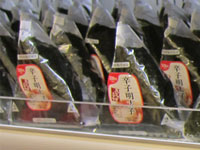 Today, onigiri is massed produced and massed marketed. At every train station’s convenience store, onigiri is an easy food item to pick up on the go. At one point in time, it was thought that onigiri would be impossible to mass produce because of the difficulty of the hand rolling technique to be accomplished by machines. However, in 1980, a machine that could create the triangle onigiri was created. Instead of having the filling placed inside the rice ball, the machine made a hole in the onigiri and inserted filling that way. The hole was then hidden by nori wrapping. However, over time, as the nori absorbed moisture from the surrounding air, they became soft, soggy and clingy. Today, onigiri is massed produced and massed marketed. At every train station’s convenience store, onigiri is an easy food item to pick up on the go. At one point in time, it was thought that onigiri would be impossible to mass produce because of the difficulty of the hand rolling technique to be accomplished by machines. However, in 1980, a machine that could create the triangle onigiri was created. Instead of having the filling placed inside the rice ball, the machine made a hole in the onigiri and inserted filling that way. The hole was then hidden by nori wrapping. However, over time, as the nori absorbed moisture from the surrounding air, they became soft, soggy and clingy.
A solution was created in time. Today, the nori is packaged separately from the rice ball and kept dry. A film of plastic separates the nori from the rice. The wrapper around the nori is to be removed and the nori can be used to wrap around the rice before eating.
Types of Filling
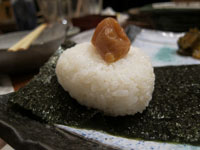 Other than the traditional fillings of umeboshi (preserved plum), okaka (dried bonito flakes), tsukundani (preserved seaweed), onigiri today feature many kinds of fillings. Some of the filling options include: tuna with mayonnaise, or shrimp with mayonnaise, dried fishes, fried tempura or cutlet, pork, roes, squid, pickled fruits and vegetables, and miso. Other than the traditional fillings of umeboshi (preserved plum), okaka (dried bonito flakes), tsukundani (preserved seaweed), onigiri today feature many kinds of fillings. Some of the filling options include: tuna with mayonnaise, or shrimp with mayonnaise, dried fishes, fried tempura or cutlet, pork, roes, squid, pickled fruits and vegetables, and miso.
Making your Own
Onigiris are not difficult to make, and with a few simple ingredients, you can make your own creative rice balls to serve friends and family, or to pack a healthy and simple lunch to school and work.
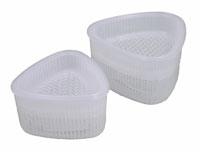 Children and adults alike will enjoy a tasty rice ball. Perfect for a summer day picnic, rice balls are rich with history and continue to be highly popular in Japan and across Asia today. Created as a way to easily enjoy rice and to take it on the go, onigiri make an easy solution for those with busy lifestyles. Children and adults alike will enjoy a tasty rice ball. Perfect for a summer day picnic, rice balls are rich with history and continue to be highly popular in Japan and across Asia today. Created as a way to easily enjoy rice and to take it on the go, onigiri make an easy solution for those with busy lifestyles.
|
|
 |
OUR 2014 NEWSLETTERS
Onigiri—Japanese Rice Balls: Traditional Convenience Food
Owls in Japan—Symbolism and Myth
Takoyaki: The street food at the Crossroad of history
White Day: The Reverse Valentine’s Day
Chinese New Year: Flowers of Celebration
Chinese Hot Pot: Gathering around Cooking
NEWSLETTER ARCHIVES
2014
2013
2012
2011
2010
2009
2008
2007
2006
2005
2004
2003
2002
2001
|